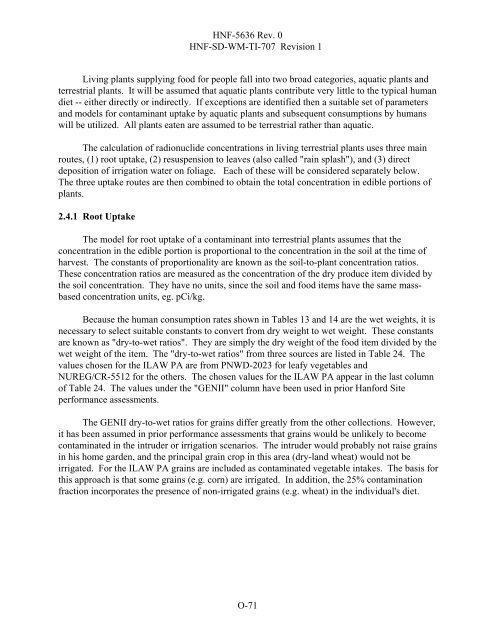appendix o exposure scenarios and unit dose factors ... - Hanford Site
appendix o exposure scenarios and unit dose factors ... - Hanford Site
appendix o exposure scenarios and unit dose factors ... - Hanford Site
You also want an ePaper? Increase the reach of your titles
YUMPU automatically turns print PDFs into web optimized ePapers that Google loves.
HNF-5636 Rev. 0<br />
HNF-SD-WM-TI-707 Revision 1<br />
Living plants supplying food for people fall into two broad categories, aquatic plants <strong>and</strong><br />
terrestrial plants. It will be assumed that aquatic plants contribute very little to the typical human<br />
diet -- either directly or indirectly. If exceptions are identified then a suitable set of parameters<br />
<strong>and</strong> models for contaminant uptake by aquatic plants <strong>and</strong> subsequent consumptions by humans<br />
will be utilized. All plants eaten are assumed to be terrestrial rather than aquatic.<br />
The calculation of radionuclide concentrations in living terrestrial plants uses three main<br />
routes, (1) root uptake, (2) resuspension to leaves (also called "rain splash"), <strong>and</strong> (3) direct<br />
deposition of irrigation water on foliage. Each of these will be considered separately below.<br />
The three uptake routes are then combined to obtain the total concentration in edible portions of<br />
plants.<br />
2.4.1 Root Uptake<br />
The model for root uptake of a contaminant into terrestrial plants assumes that the<br />
concentration in the edible portion is proportional to the concentration in the soil at the time of<br />
harvest. The constants of proportionality are known as the soil-to-plant concentration ratios.<br />
These concentration ratios are measured as the concentration of the dry produce item divided by<br />
the soil concentration. They have no <strong>unit</strong>s, since the soil <strong>and</strong> food items have the same massbased<br />
concentration <strong>unit</strong>s, eg. pCi/kg.<br />
Because the human consumption rates shown in Tables 13 <strong>and</strong> 14 are the wet weights, it is<br />
necessary to select suitable constants to convert from dry weight to wet weight. These constants<br />
are known as "dry-to-wet ratios". They are simply the dry weight of the food item divided by the<br />
wet weight of the item. The "dry-to-wet ratios" from three sources are listed in Table 24. The<br />
values chosen for the ILAW PA are from PNWD-2023 for leafy vegetables <strong>and</strong><br />
NUREG/CR-5512 for the others. The chosen values for the ILAW PA appear in the last column<br />
of Table 24. The values under the "GENII" column have been used in prior <strong>Hanford</strong> <strong>Site</strong><br />
performance assessments.<br />
The GENII dry-to-wet ratios for grains differ greatly from the other collections. However,<br />
it has been assumed in prior performance assessments that grains would be unlikely to become<br />
contaminated in the intruder or irrigation <strong>scenarios</strong>. The intruder would probably not raise grains<br />
in his home garden, <strong>and</strong> the principal grain crop in this area (dry-l<strong>and</strong> wheat) would not be<br />
irrigated. For the ILAW PA grains are included as contaminated vegetable intakes. The basis for<br />
this approach is that some grains (e.g. corn) are irrigated. In addition, the 25% contamination<br />
fraction incorporates the presence of non-irrigated grains (e.g. wheat) in the individual's diet.<br />
O-71

















